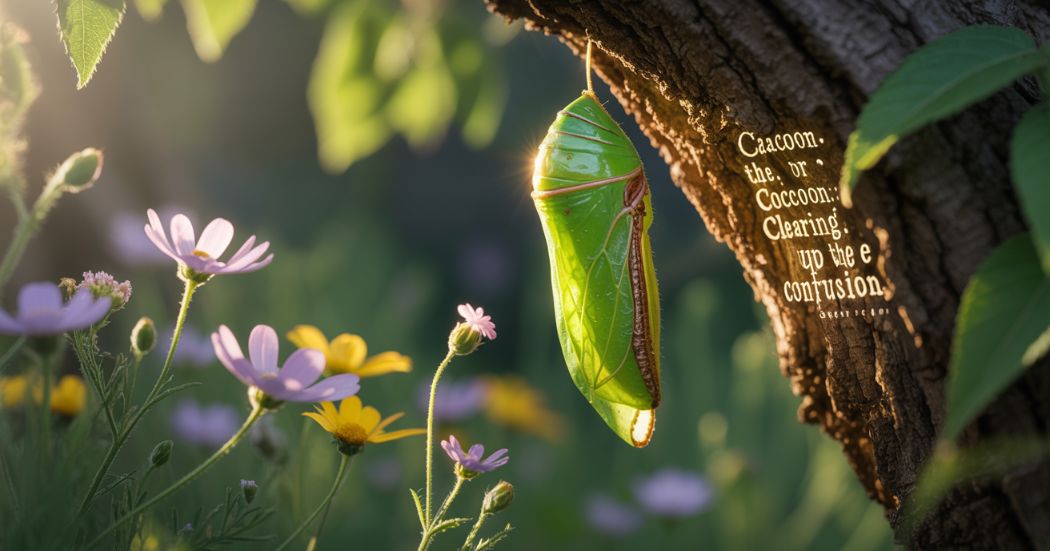Language evolves, but sometimes, we stumble upon words that cause more confusion than clarity. One such pair that frequently trips up writers, students, and even professionals is “Cacoon” versus “Cocoon.” While they may look and sound similar, only one of these is a legitimate word in English the other is a common misspelling.
Let’s unpack these terms, understand their meanings (or lack thereof), and look at real-world examples to help cement the correct usage in your mind.
What is a Cocoon?
A cocoon is a protective case spun by the larvae of insects, especially moths and butterflies, as they develop into adults. Metaphorically, it also refers to a safe, secluded, or insulating environment.
The word “cocoon” can function both as a noun and a verb:
- As a noun: The caterpillar spun a cocoon to begin its transformation.
- As a verb: She cocooned herself in blankets during the winter storm.
Key Definitions:
- Cocoon (noun): A silky case spun by insect larvae.
- Cocoon (verb): To envelop or surround in a protective or comforting layer.
What is Cacoon?
Here’s the truth: “Cacoon” is not a standard English word.
“Cacoon” is a common misspelling or typo of “cocoon.” Despite its frequent appearance in informal writing or internet searches, it does not appear in dictionaries such as Merriam-Webster, Oxford English Dictionary, or Cambridge Dictionary.
That said, there is one minor exception the term “Cacoon” has been used as a brand name for a line of hanging chairs and tents. So if you’ve seen “Cacoon” in the context of outdoor furniture or decor, that’s probably what it referred to.
Why Do People Confuse Cacoon and Cocoon?
There are a few reasons this confusion happens:
1. Phonetic Similarity
Both “cocoon” and “cacoon” are pronounced the same: /kəˈkuːn/. When spoken aloud, there’s no audible difference, making it easy for someone to spell it phonetically and incorrectly.
2. Autocorrect and Typing Errors
Typing quickly on smartphones or computers often leads to typos. Some spellcheckers might not flag “cacoon” as incorrect — especially if it’s used repeatedly or saved in a custom dictionary.
3. Limited Exposure to Correct Spelling
Many people have never read the word “cocoon” in print, even though they’ve heard it spoken. This makes them rely on phonetics rather than verified spelling.
Common Scenarios and Examples
Scenario 1: Nature and Science
Imagine a third-grade science teacher explaining metamorphosis:
❌ Incorrect: The caterpillar makes a cacoon before becoming a butterfly.
✅ Correct: The caterpillar makes a cocoon before becoming a butterfly.
Here, using the correct spelling is important not only for accuracy but for the sake of scientific literacy.
Scenario 2: Emotional or Metaphorical Usage
Let’s say a novelist is describing a character’s emotional withdrawal after a breakup:
❌ Incorrect: After the heartbreak, she wrapped herself in a cacoon of silence.
✅ Correct: After the heartbreak, she wrapped herself in a cocoon of silence.
In this metaphorical usage, the word “cocoon” paints a vivid picture of emotional self-protection. The incorrect spelling weakens the prose and may disrupt a reader’s immersion.
Scenario 3: Product Branding Confusion
Suppose someone is shopping for a unique hanging tent and sees two different spellings online:
- “Cacoon hanging chair”
- “Cocoon hanging chair”
In this case, the term “Cacoon” might actually refer to a registered brand. But when you’re writing about the biological term or metaphorical sense, always go with “cocoon.”
Tips to Remember the Correct Word
1. Think of the Butterfly
The image of a butterfly emerging from a cocoon is powerful and widely recognized. Associating the word “cocoon” with transformation and nature can help you remember its correct spelling.
2. Break Down the Word
Cocoon comes from the French word cocon, which means “egg shell” or “protective covering.” This etymology reminds us that it’s not related to “caca” (as in “cacophony” or “cactus”), which could lead to the incorrect “cacoon.”
3. Use Mnemonics
Try this trick:
Cocoon = Covering Of Caterpillars Of Nature
It’s a bit of a stretch, but it helps reinforce the connection to insect metamorphosis and the correct spelling
When Might “Cacoon” Be Acceptable?
There’s only one narrow context where “Cacoon” could be considered not a mistake — as a brand name or proper noun.
For instance:
✅ “We bought a Cacoon tent for our backyard, and it’s incredibly cozy.”
In this case, “Cacoon” with a capital C is used similarly to how one might refer to a Kleenex or Band-Aid — it’s a specific product, not a general term.
But outside of that usage, stick with “cocoon.”
The Importance of Getting It Right
In writing — whether academic, creative, or professional — accuracy matters. A simple misspelling like “cacoon” may seem minor, but it can:
- Undermine your credibility
- Confuse your reader
- Disrupt the flow of your writing
Tools like Grammarly or built-in spellcheckers can catch many errors, but not all. That’s why it’s important to proofread carefully, especially when you’re using less common words.
Final Thoughts
While it might be easy to confuse “cacoon” and “cocoon”, only one of them is correct in most contexts. “Cocoon” is the right word when you’re referring to a protective shell, either in nature or metaphorically. “Cacoon” is a misspelling except when used as a brand name.
By understanding the correct usage and seeing real-world examples, you can avoid this common pitfall in your writing.
So next time you’re tempted to write “cacoon,” pause for a moment and think: Am I talking about butterflies, safety, or transformation? If yes the word you’re looking for is cocoon.


